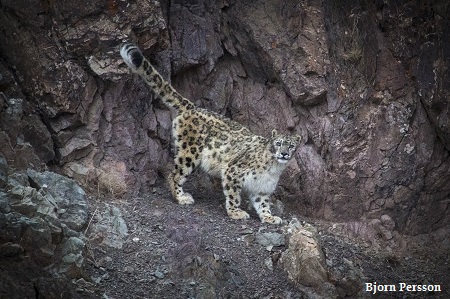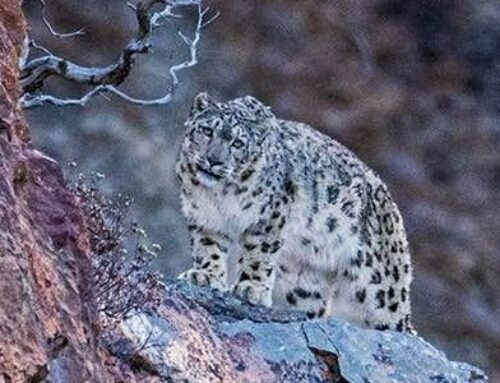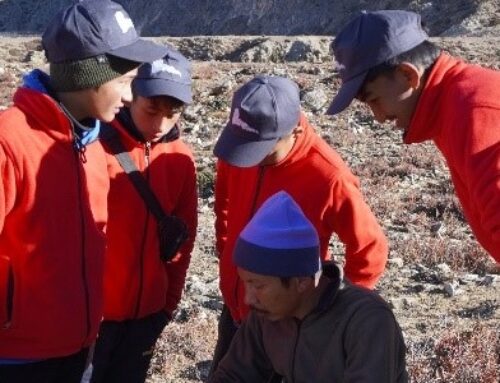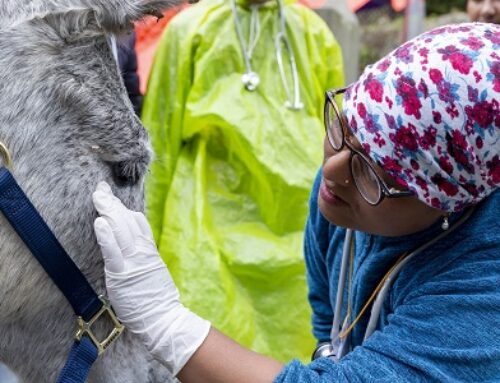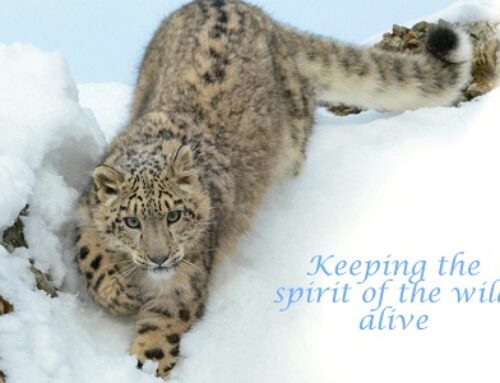In a major scientific discovery, a team of researchers has announced that there appear to be three subspecies of the snow leopard. Until now, the elusive snow leopard, which inhabits a vast area of 1.6 million sq. km across multiple countries in Central and South Asia, was thought to be a single or “monotypic” species (Panthera uncia). Despite the enormous size of its global range, hunting and poaching have taken a serious toll on the animal’s population, which today, is estimated to be only 3,500 to about 7000 wild cats.
The researchers, including co-investigators Dr. Rodney Jackson, Director-Founder of the Snow Leopard Conservancy in Sonoma, California, Tshewang Wangchuk, Executive Director of the Bhutan Foundation, who also serves on the Snow Leopard Conservancy’s Board of Directors, and Dr. Jan E. Janecka, Duquesne University, in close partnership with 20 different institutions, obtained samples of the animal’s scat (i.e., droppings) from wildlife trails and other areas frequented by the big cats, and then, analyzed the DNA in the samples. The DNA analysis revealed three distinct “genetic clusters” that are geographically separated and warrant subspecies status – the Northern subspecies Panthera uncia irbis found in the Altai region, the Central subspecies Panthera uncia uncioides, found in the core Himalaya and Tibetan Plateau and the Western subspecies Panthera uncia uncia found in the Tian Shan, Pamir and trans-Himalaya mountain ranges.
Each of the proposed subspecies spans international borders, with about 40 percent of the cat’s global range considered trans-boundary – thus underscoring the need for international cooperation. The snow leopard remained the last of the five big cats to be the subject of a comprehensive subspecies assessment, in part, because its habitat, including some of the highest and coldest mountain ranges in the world, is so inhospitable.
Based on their analysis of the animal’s DNA, the researchers believe that the snow leopard underwent a genetic bottleneck approximately 8,000 years ago during what is called the Holocene Thermal Optimum, a period of time characterized by warmer temperatures, precipitation, and a tree-line shift to higher elevations on the Tibetan Plateau. This suggests that snow leopards may be particularly sensitive to climate change, and according to Dr. Jackson, such changes are also expected to have a pervasive impact on the pastoralists who share the same habitat over this vast area.
Ultimately, delineating or separating Panthera uncia into subspecies provides scientists with a better understanding of the animal’s evolution and ecology. The discovery of the three new subspecies of snow leopards, however is not a mere academic exercise, but will have significant conservation implications. As Dr. Jackson observes, “results from our genetics study help us better understand how snow leopard populations are connected and could benefit from strategically-targeted conservation actions to ensure continued genetic interchange.”
The 12 countries the comprise the snow leopard’s range – Afghanistan, Bhutan, China, India, Kazakhstan, Kyrgyzstan, Mongolia, Nepal, Pakistan, Russia, Tajikistan, and Uzbekistan – have joined together to designate 20 protected landscapes by 2020 to each support at least 100 breeding snow leopards, as part of an international effort called the Global Snow Leopard & Ecosystem Protection Program (“GSLEP”). The researchers hope that their work will not only encourage the GSLEP to designate the protected landscapes, as expeditiously as possible, but implement trans-boundary and more flexible conservation measures recognizing the genetic distinctness of the three newly discovered subspecies.
The scientific article Range-Wide Snow Leopard Phylogeography Supports Three Subspecies, documenting the researchers’ ground-breaking discoveries, appears online in the Journal of Heredity published by the Oxford University Press:
https://academic.oup.com/jhered/article/3796316/Range-Wide-Snow-Leopard-Phylogeography-Supports
Dr. Jackson, Director of the Snow Leopard Conservancy in Sonoma, California was instrumental in making the genetics study possible by collaborating with the other researchers, including in-country biologists, building partnerships with local communities, NGOs, and government institutions with financial support from the National Geographic Society and others.
The Snow Leopard Conservancy, headquartered in Sonoma, California, implements numerous conservation programs that support snow leopards, local conservation stewardship, and sustainable development.
May 11, 2017
Please direct correspondence to:
Dr. Rodney Jackson, Director
Snow Leopard Conservancy
75 Boyes Blvd., Sonoma, CA 95476
(707) 938-1700
email: rodney@snowleopardconservancy.org
Website: www.SnowLeopardConservancy.org
or
Dr. Jan E. Janecka
Assistant Professor
Bayer School of Natural and Environmental Sciences
236 Mellon Hall
Department of Biological Sciences
Duquesne University
janekaj@duq.edu
To request a copy of the article, please contact
Daniel Luzer: Daniel.luzer@oup.com
Photo courtesy of Bjorn Persson

